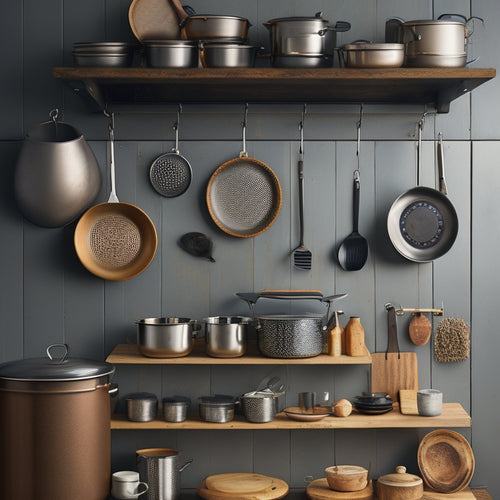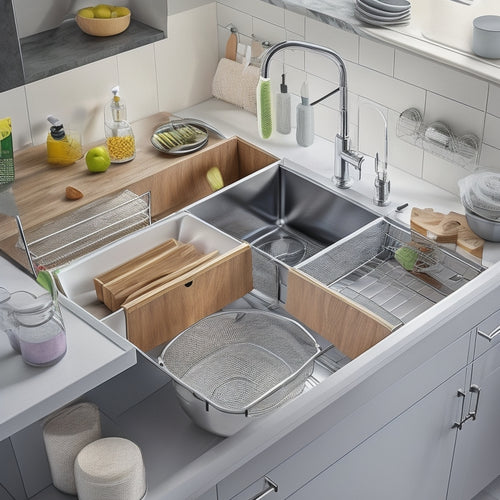
7 Essential Tips to Tame Kitchen Utensil Clutter
Share
You're likely tired of digging through cluttered utensil drawers and cabinets. To tame the chaos, start by purging unnecessary items to free up space. Then, assign a home for each utensil, utilizing vertical storage spaces for efficient organization. Invest in multipurpose utensils to reduce clutter, and designate zones for specific utensil types. Implement a maintenance routine to keep your system running smoothly. Maximize drawer and cabinet space with organizational tools, and consider implementing a utensil rotation system for easy access. By following these essential tips, you'll be well on your way to a more organized kitchen - and there's even more to discover.
Key Takeaways
• Purge unused utensils to free up space and improve kitchen efficiency by only keeping essential items organized by function and purpose.
• Create zones for different utensil categories, assigning specific areas for each type, and utilize dividers or containers for visual appeal and easy access.
• Maximize vertical storage spaces with shelves, hooks, or pegboards for additional storage, and hang utensils for easy access and visibility.
• Invest in multipurpose utensils that serve multiple functions to reclaim kitchen space and enjoy a streamlined cooking process.
• Establish a maintenance routine, including daily wiping and weekly cleaning, and utilize organizational tools like labels and dividers to maintain order.
Purge Unnecessary Kitchen Utensils
Get rid of any kitchen utensil that you haven't used in the past year, as it's likely taking up valuable space and contributing to clutter. Be honest with yourself - if you haven't used it in 12 months, you probably won't miss it. This is the first step in taming your kitchen utensil clutter.
Organize by function by grouping similar items together, such as baking utensils, cooking utensils, and serving utensils. This will give you a clear picture of what you have and what you can get rid of.
Declutter by purpose by asking yourself if each utensil serves a specific purpose. If it doesn't, consider letting it go. By doing this, you'll be left with a collection of utensils that are useful and functional.
You'll be surprised at how much more efficient your kitchen will become once you've purged the unnecessary items. With a more streamlined collection, you'll be able to focus on what really matters - cooking and enjoying meals with your loved ones.
Assign a Home for Each Item
Now that you've purged your kitchen of unnecessary utensils, it's time to assign a home for each item that's left.
You'll want to create zones for different categories of utensils, such as baking or cooking, to make them easy to find when you need them.
Utensil Category Zones
Assign each utensil category a specific zone in your kitchen, ensuring that similar items are stored together in a designated area. This approach helps maintain order and makes it easier to find what you need when you need it.
For instance, designate a zone for baking utensils, such as whisks, spatulas, and measuring cups. Another zone can be for cooking utensils, like tongs, spoons, and ladles.
Organizing by color is also an effective way to categorize utensils. Store utensils with similar colors together, making it visually appealing and easy to navigate. Utilizing dividers or small containers within each zone can further separate items and keep them organized.
For example, use a divider to separate wooden spoons from metal ones or to store utensils with different functions, like spatulas for flipping and serving.
Designate Daily Use Area
Identify the utensils you use daily and assign a specific home for each item, making sure it's easily accessible and convenient to grab when needed. This will help you maintain a clutter-free kitchen and save time while cooking.
Allocate a specific drawer, container, or hook for each utensil, and ensure it's near your prepping station. This way, you can quickly grab the utensils you need without having to search the entire kitchen.
Implement a utensil rotation system to guarantee that the most frequently used items are at the front and center. This will prevent you from having to dig through a cluttered drawer or container to find what you need.
By specifying a daily use area, you'll be able to keep your kitchen organized and functional. You'll also reduce the likelihood of utensils getting lost or damaged.
With a designated home for each item, you'll be able to focus on cooking and enjoying your meals, rather than wasting time searching for the right utensil.
Utilize Vertical Storage Spaces
By installing shelves, hooks, or a pegboard on your kitchen walls or the back of a door, you can create additional storage space for utensils, freeing up countertops and drawers. This is especially useful for items you don't use frequently, like special occasion dishes or infrequently used cookware.
Here are some ideas to get you started:
| Storage Option | Description | Benefits |
|---|---|---|
| Hanging hooks | Hang utensils like pots, pans, and utensils | Easy access, saves counter space |
| Wall racks | Store plates, bowls, and cups | Keeps items organized, visible |
| Pegboard | Organize utensils, spices, and oils | Customizable, easy to clean |
Invest in Multipurpose Utensils
When you invest in multipurpose utensils, you're not only reducing clutter but also streamlining your cooking process.
You'll appreciate the space-saving design of these utensils, which means fewer pieces to store in your kitchen.
Space-Saving Design Matters
You'll be surprised how much kitchen real estate you can reclaim by swapping out single-function utensils for multipurpose ones that serve several purposes at once. This is where space-saving design matters. By investing in compact and efficient utensils, you can create a more organized kitchen with plenty of room to breathe.
Here are some examples of multipurpose utensils that can help you achieve compact organization and efficient storage:
| Utensil | Functions | Benefits |
|---|---|---|
| Silicone Spatula | Scraping, flipping, serving | Heat-resistant, non-stick, and easy to clean |
| Instant Read Thermometer | Meat, candy, and oil temperature | Fast and accurate readings, compact design |
| Garlic Press | Crushing garlic, ginger, and herbs | Easy to use and clean, takes up little space |
| Spiralizer | Vegetable peeler, spiral cutter, and slicer | Versatile, compact, and easy to store |
| Adjustable Measuring Spoon | Measuring dry and liquid ingredients | Space-saving, adjustable, and accurate |
Fewer Pieces to Store
Regularly swapping single-purpose utensils for multipurpose ones can greatly reduce the number of pieces to store in your kitchen. This simple switch can have a significant impact on your utensil organization and overall kitchen decluttering efforts.
By investing in multipurpose utensils, you'll find that you need fewer pieces to accomplish the same tasks. For example, a silicone spatula with a built-in scraper can replace a separate spatula and scraper. Similarly, a chef's knife with a built-in sharpener can eliminate the need for a separate sharpener.
As you replace single-purpose utensils with multipurpose ones, you'll notice a significant reduction in the number of pieces you need to store. This, in turn, will free up valuable space in your kitchen and make it easier to maintain your utensil organization system.
Streamlined Cooking Process
By investing in multipurpose utensils, you can greatly streamline your cooking process, freeing up time and energy to focus on the culinary aspects of meal preparation. With fewer utensils to juggle, you'll reduce the likelihood of misplacing or dropping them, allowing you to stay focused on the task at hand.
Multipurpose utensils are designed to serve multiple purposes, eliminating the need for multiple single-function tools. This means you'll spend less time searching for the right utensil, and more time on efficient meal prep.
For example, a silicone spatula with a built-in scraper can replace multiple utensils, saving you time and storage space.
Designate Zones for Utensil Types
Divide your kitchen into zones dedicated to specific utensil types, such as a baking station or a food prep area, to keep similar items organized and within easy reach. This approach helps you create an efficient organizational system, making it easier to find what you need when you need it. By grouping similar utensils together, you'll reduce clutter and increase productivity in the kitchen.
Here are some benefits of designating zones for utensil types:
-
Less clutter: With a designated zone for each utensil type, you'll be less likely to have utensils scattered throughout the kitchen, making it easier to maintain a clutter-free space.
-
Increased efficiency: When utensils are organized by type, you can quickly find what you need, saving you time and effort in the kitchen.
-
Improved utensil rotation: By storing utensils in designated zones, you're more likely to use and rotate them regularly, ensuring that your most frequently used items are always within easy reach.
Implement a Maintenance Routine
Set aside a few minutes each week to tidy up your utensil zones, making sure everything remains organized and easily accessible. This maintenance routine will help prevent clutter from building up again. Create a cleaning schedule that works for you, whether it's daily, weekly, or bi-weekly, and stick to it.
| Task | Frequency |
|---|---|
| Wipe down utensil zones | Daily |
| Put away utensils after use | Daily |
| Clean organization bins | Weekly |
| Rotate utensils to guarantee even wear | Bi-Weekly |
| Deep clean utensil zones | Monthly |
A labeling system will also help you stay on track. Label each organization bin and utensil zone so you can easily identify where everything goes. This will also encourage you to put things back in their proper place. Implementing a utensil rotation system will make sure that all your utensils get used and prevent some from getting worn out faster than others. By following these simple steps, you'll be able to maintain your organized kitchen utensil zones with ease.
Maximize Drawer and Cabinet Space
To optimize your kitchen's storage capacity, start by evaluating the layout and contents of your drawers and cabinets, identifying areas where utensils are cramped or hidden from view. This will help you determine the most effective ways to utilize the space you have.
Next, consider implementing some organizational tools to maximize your storage capacity. Here are a few ideas:
-
Use drawer dividers to separate utensils and keep them organized, making it easier to find what you need when you need it.
-
Install magnetic hooks on the side of a cabinet or fridge to hang frequently used items like oven mitts or utensils, keeping them within easy reach.
-
Utilize wall mounted racks or over the door organizers to store less frequently used items, like special occasion dishes or infrequently used cookware, keeping them out of the way but still accessible.
Related Posts
-

7 Essential Tips for Pot and Pan Storage
You're tired of digging through a cluttered kitchen for the right pot or pan, and frustrated with the scratches and d...
-

Streamlined Kitchen Sink Organization Solution
A streamlined kitchen sink organization solution must balance functionality with aesthetics. A well-designed system s...
-

LYNK PROFESSIONAL: Transform Your Under-Sink Storage
Transform your under-sink storage with LYNK PROFESSIONAL, a cleverly designed system that tackles common challenges. ...


